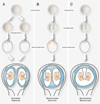Birth defects associated with perturbations in preimplantation, gastrulation, and axis extension: from conjoined twinning to caudal dysgenesis
- PMID: 24014416
- PMCID: PMC4069860
- DOI: 10.1002/wdev.97
Birth defects associated with perturbations in preimplantation, gastrulation, and axis extension: from conjoined twinning to caudal dysgenesis
Abstract
Congenital malformations represent approximately 3 in 100 live births within the human population. Understanding their pathogenesis and ultimately formulating effective treatments are underpinned by knowledge of the events and factors that regulate normal embryonic development. Studies in model organisms, primarily in the mouse, the most prominent genetically tractable mammalian model, have equipped us with a rudimentary understanding of mammalian development from early lineage commitment to morphogenetic processes. In this way, information provided by studies in the mouse can, in some cases, be used to draw parallels with other mammals, including human. Here, we provide an overview of our current understanding of the general sequence of developmental events from early cell cleavages to gastrulation and axis extension occurring in human embryos. We will also review some of the rare birth defects occurring at these stages, in particular those resulting in conjoined twinning or caudal dysgenesis.
Copyright © 2012 Wiley Periodicals, Inc.
Figures






Similar articles
-
Caudal duplication--a case report.Pediatr Surg Int. 2000;16(5-6):445-6. doi: 10.1007/s003839900313. Pediatr Surg Int. 2000. PMID: 10955588
-
Unusual case of epigastric heteropagus twinning.J Pediatr Surg. 2005 Mar;40(3):E39-41. doi: 10.1016/j.jpedsurg.2004.11.006. J Pediatr Surg. 2005. PMID: 15793712
-
The embryology of conjoined twins.Childs Nerv Syst. 2004 Aug;20(8-9):508-25. doi: 10.1007/s00381-004-0985-4. Epub 2004 Jul 27. Childs Nerv Syst. 2004. PMID: 15278382 Review.
-
Naturally occurring, rostrally conjoining chicken twins attempt to make a forebrain.Dev Biol. 2025 Apr;520:171-179. doi: 10.1016/j.ydbio.2025.01.013. Epub 2025 Jan 21. Dev Biol. 2025. PMID: 39848482
-
Deciphering caudal embryonic defects: embryological analysis and reviewing literature data.Rom J Morphol Embryol. 2012;53(4):1013-20. Rom J Morphol Embryol. 2012. PMID: 23303026 Review.
Cited by
-
Descriptive and risk factor analysis of nonsyndromic sacral agenesis: National Birth Defects Prevention Study, 1997-2011.Am J Med Genet A. 2019 Sep;179(9):1799-1814. doi: 10.1002/ajmg.a.61290. Epub 2019 Jul 11. Am J Med Genet A. 2019. PMID: 31294918 Free PMC article.
-
Ubiquitin ligases: guardians of mammalian development.Nat Rev Mol Cell Biol. 2022 May;23(5):350-367. doi: 10.1038/s41580-021-00448-5. Epub 2022 Jan 25. Nat Rev Mol Cell Biol. 2022. PMID: 35079164 Review.
-
Interspecies control of development during mammalian gastrulation.Emerg Top Life Sci. 2023 Dec 18;7(4):397-408. doi: 10.1042/ETLS20230083. Emerg Top Life Sci. 2023. PMID: 37933589 Free PMC article. Review.
-
Season, household registry and isolated birth defects: a population-based case-control study in Danyang, China.Int Health. 2024 Sep 5;16(5):562-567. doi: 10.1093/inthealth/ihae034. Int Health. 2024. PMID: 38801353 Free PMC article.
-
Gastrulation : Current Concepts and Implications for Spinal Malformations.J Korean Neurosurg Soc. 2021 May;64(3):329-339. doi: 10.3340/jkns.2020.0125. Epub 2020 Dec 16. J Korean Neurosurg Soc. 2021. PMID: 33321561 Free PMC article.
References
-
- Thomson JA, Itskovitz-Eldor J, Shapiro SS, Waknitz MA, Swiergiel JJ, Marshall VS, Jones JM. Embryonic stem cell lines derived from human blastocysts. Science. 1998;282:1145–1147. - PubMed
-
- Rossant J, Tam PP. Blastocyst lineage formation, early embryonic asymmetries and axis patterning in the mouse. Development. 2009;136:701–713. - PubMed
-
- Lanner F, Rossant J. The role of FGF/Erk signaling in pluripotent cells. Development. 2010;137:3351–3360. - PubMed
Publication types
MeSH terms
Supplementary concepts
Grants and funding
LinkOut - more resources
Full Text Sources

